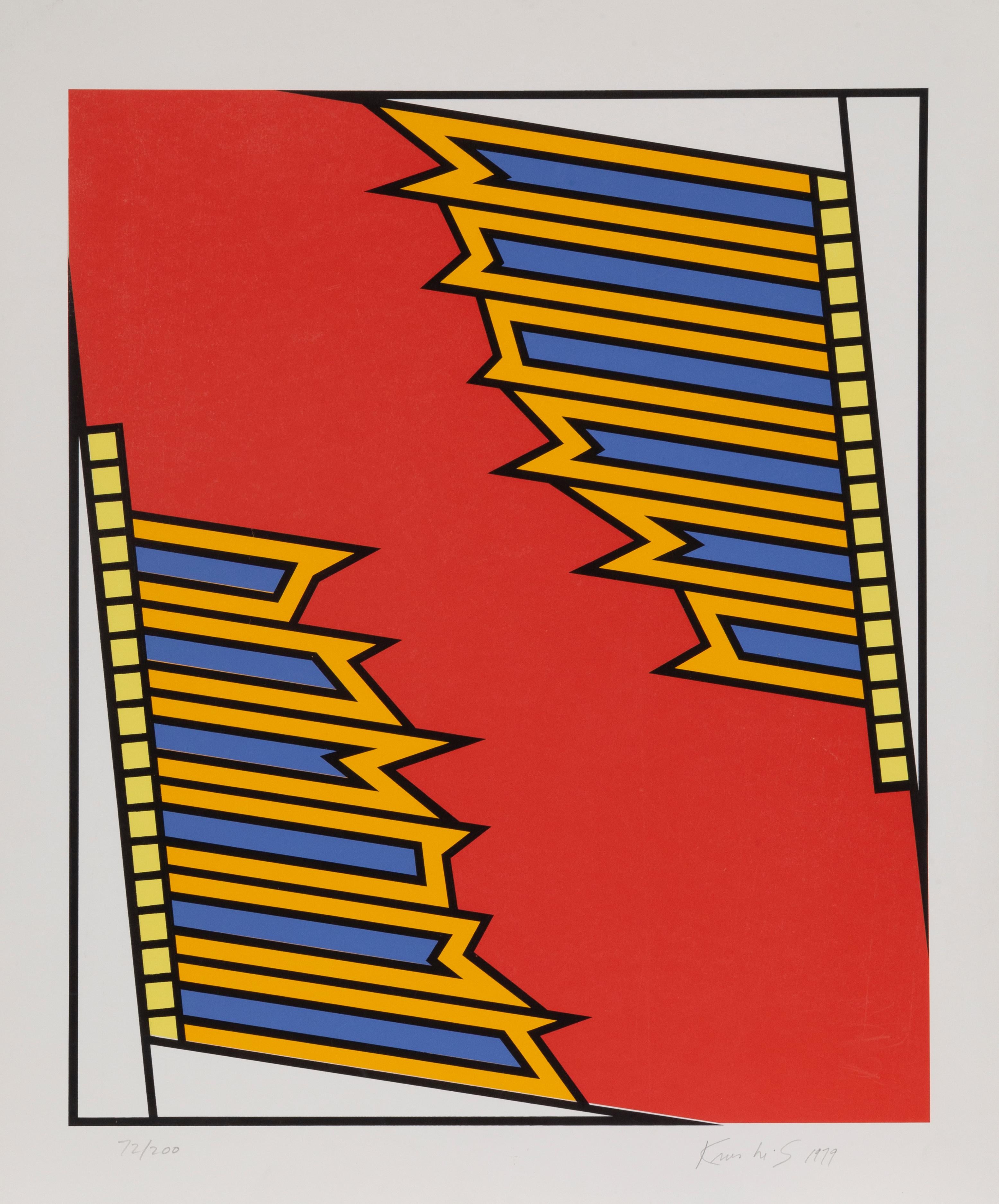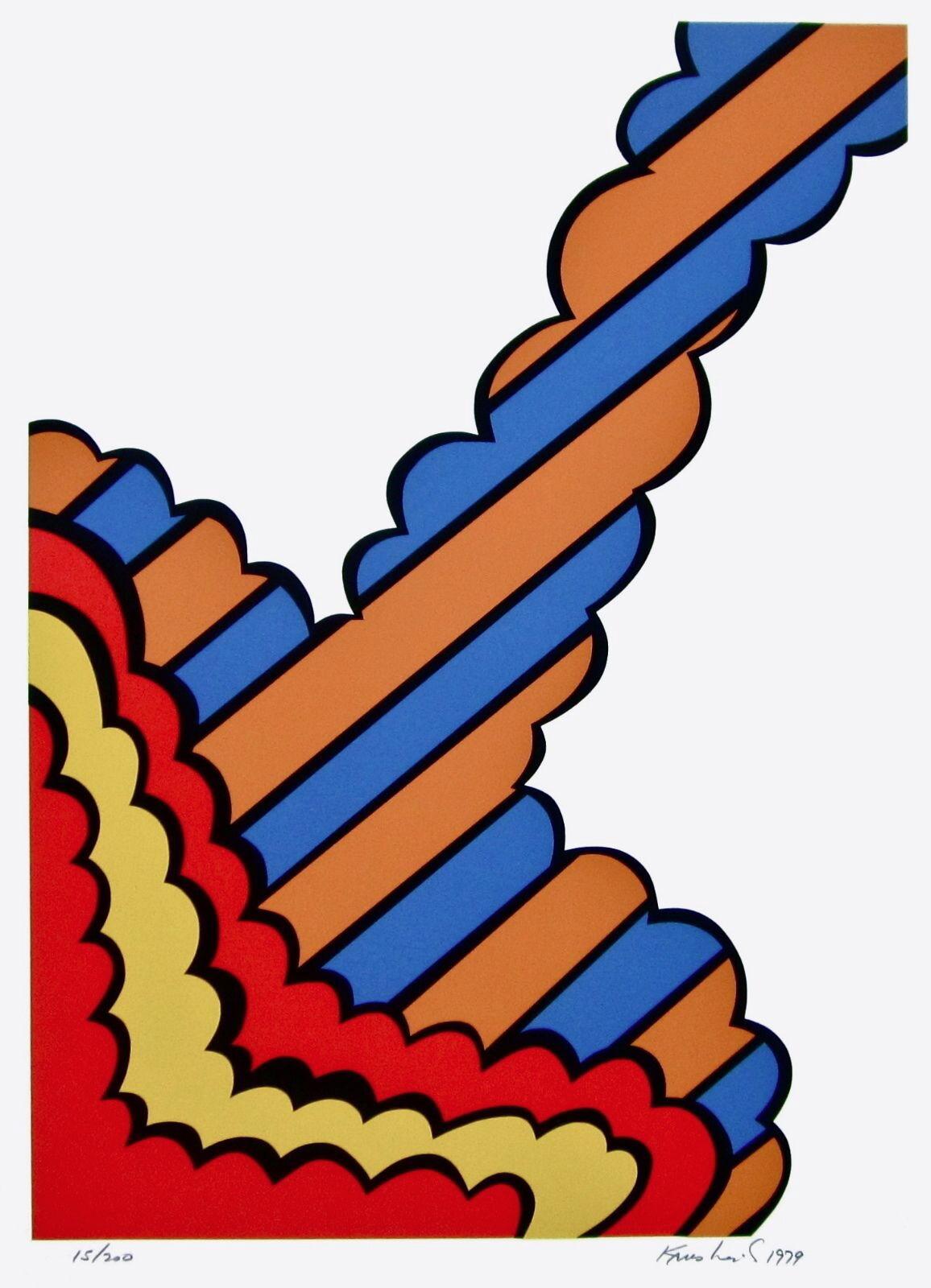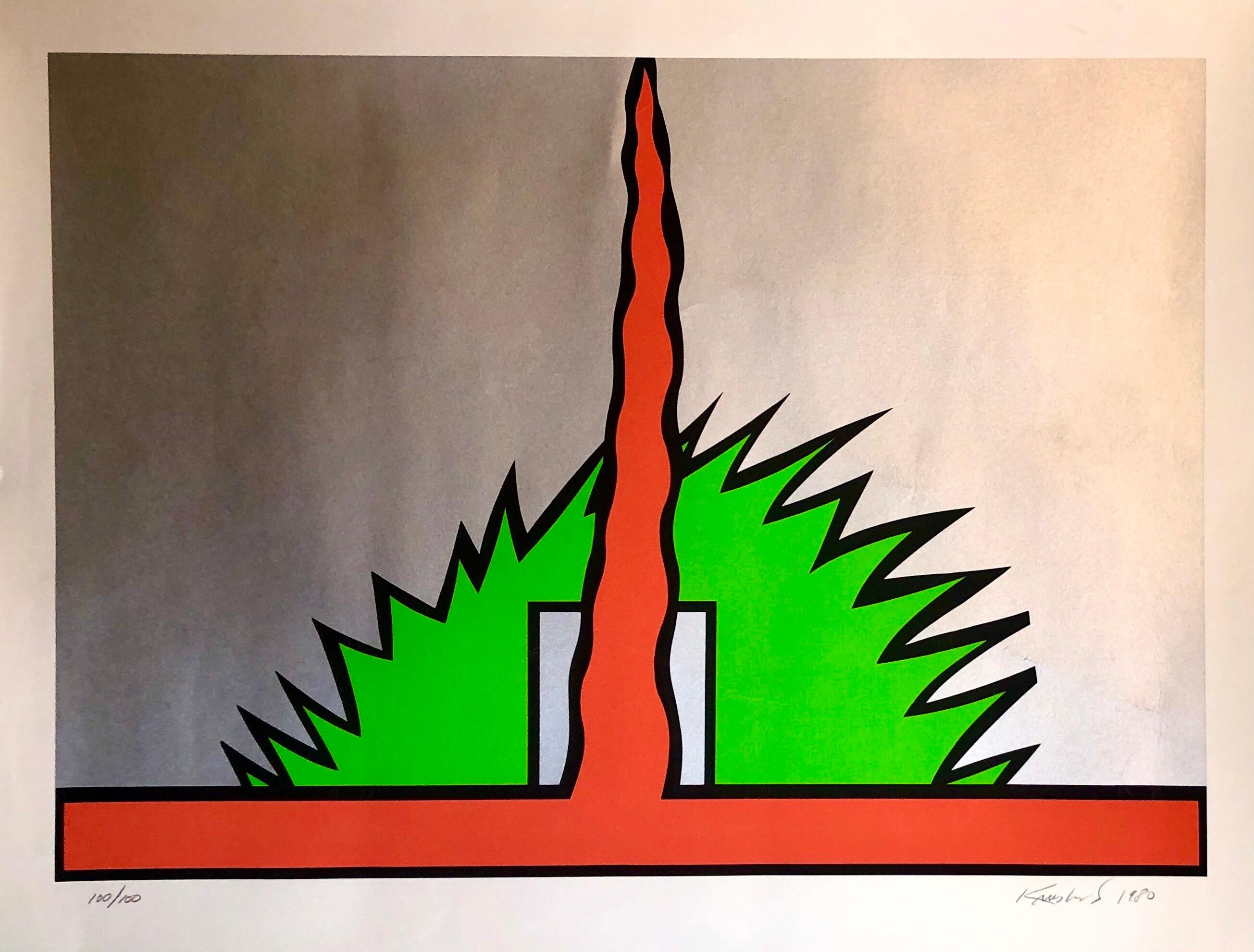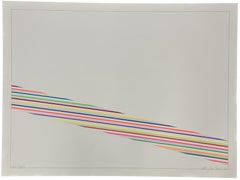Items Similar to Over The Rainbow Signed Limited Edition Screen Print 1978
Want more images or videos?
Request additional images or videos from the seller
1 of 8
Nicholas KrushenickOver The Rainbow Signed Limited Edition Screen Print 19781978
1978
$1,000
£746.95
€865.97
CA$1,388.48
A$1,556.30
CHF 810.32
MX$19,003.11
NOK 10,288.13
SEK 9,752.22
DKK 6,461.09
Shipping
Retrieving quote...The 1stDibs Promise:
Authenticity Guarantee,
Money-Back Guarantee,
24-Hour Cancellation
About the Item
Nicholas Krushenick
Over The Rainbow - 1978
Print Type: Screen Print on Somerset paper
Size-Width Size-Height: 27.3'' x 37.5'' inches
Signed Edition Size: Signed in pencil and marked 23/200
Unframed
One of America’s premier Pop artists, Nicholas Krushenick’s work consists of geometric abstract motifs whose shapes were outlined in heavy black lines. In this regard his original prints were often compared to those of Pop Art co-horts Roy Lichtenstein and Andy Warhol, but unlike these masters Krushenick avoided any imagery from commercial art. More than one critic termed the art of Krushenick as ‘Abstract Pop’.
His work is held in many museums across the country including the Whitney Museum of American Art, Dallas Museum of Art, Amon Carter Museum, Denver Art Museum, and many more.
- Creator:Nicholas Krushenick (1929-1999, American)
- Creation Year:1978
- Dimensions:Height: 27.3 in (69.35 cm)Width: 37.5 in (95.25 cm)Depth: 1 in (2.54 cm)
- Medium:
- Movement & Style:
- Period:
- Condition:
- Gallery Location:Rochester Hills, MI
- Reference Number:1stDibs: LU2335213728282
Nicholas Krushenick
orn in the Bronx, New York in 1929, Nicholas Krushenick studied painting at the Art Students League of New York and the Hans Hofmann School of Fine Arts. After completing his training, Krushenick designed window displays and worked in the Framing Department of the Museum of Modern Art. From 1957 to 1962, the artist, along with his brother John, operated the now legendary Brata Gallery in Manhattan’s East Village. Brata displayed the works of many of the foremost artists of the day, including, among others: Ronald Bladen, Ed Clarke, Al Held, Yayoi Kusama, and George Sugarman. Krushenick first developed his signature “pop abstract” style in the early 1960s. The loose geometries and web-like forms of his early paintings demonstrate his deliberate caricature of Abstract Expressionist “drips” or “skeins” into what more closely resemble details from cartoons—like Superman’s hair follicles, as critic Robert Rosenblum once described. The high-keyed color, formal rigor, and sheer graphic intensity of his paintings set Krushenick apart from his contemporaries. As a result, decades after its creation, Krushenick’s work still appears remarkably fresh. During the 1960s and 1970s, Krushenick had solo exhibitions at many of the most influential and prestigious galleries, including: Graham Gallery (1958, 1962, 1964, New York), Fischbach Gallery (1965, New York), Galerie Sonnabend (1967, Paris), Galerie Ziegler (1969, Zürich), Galerie Beyeler (1971, Basel), and Pace Gallery (1967, 1969, 1972, New York). During this period, his work also figured prominently in many landmark museum exhibitions, such as Post Painterly Abstraction (1964, Los Angeles County Museum of Art), Vormen van de Kleur (1964, Stedelijk Museum), Systemic Painting (1965, Solomon R. Guggenheim Museum), and Documenta 4 (1968, Fredericianum), among others. In 1968, the Walker Art Center mounted a retrospective exhibition of Krushenick’s work. His first European retrospective came four years later, in 1972, at the Kestner-Gesellschaft in Hannover, Germany. In 2015 he had a retrospective at the Tang Gallery, Skidmore College, Saratoga Springs, New York entitled Nicholas Krushenick: Electric Soup. Krushenick’s work is featured in the collections of over sixty major museums, including: the Albright-Knox Art Gallery; the Baltimore Museum of Art; the Cleveland Museum of Art; the Dallas Museum of Fine Art; the Empire State Art Collection; the Grey Art Gallery, New York University; the Los Angeles County Museum of Art; the Metropolitan Museum of Art; the Museum of Modern Art; San Francisco Museum of Modern Art; the Smithsonian American Art Museum, Washington, D.C.; the Stedelijk Museum; the Virginia Museum of Fine Arts, Richmond; the Walker Art Center, Minneapolis; and the Whitney Museum of American Art.
About the Seller
4.8
Vetted Professional Seller
Every seller passes strict standards for authenticity and reliability
Established in 2000
1stDibs seller since 2023
78 sales on 1stDibs
Typical response time: <1 hour
- ShippingRetrieving quote...Shipping from: Rochester Hills, MI
- Return Policy
Authenticity Guarantee
In the unlikely event there’s an issue with an item’s authenticity, contact us within 1 year for a full refund. DetailsMoney-Back Guarantee
If your item is not as described, is damaged in transit, or does not arrive, contact us within 7 days for a full refund. Details24-Hour Cancellation
You have a 24-hour grace period in which to reconsider your purchase, with no questions asked.Vetted Professional Sellers
Our world-class sellers must adhere to strict standards for service and quality, maintaining the integrity of our listings.Price-Match Guarantee
If you find that a seller listed the same item for a lower price elsewhere, we’ll match it.Trusted Global Delivery
Our best-in-class carrier network provides specialized shipping options worldwide, including custom delivery.More From This Seller
View AllColor Steps D Signed Limited Edition Screen Print
By John Plumb
Located in Rochester Hills, MI
John Plumb
'Colour Step D'
1971
Medium Type: Screen Print
Size-Width Size-Height: 22'' x 30''
Signed
Edition Size: Signed in pencil, titled and marked 19/75
John Plumb is one o...
Category
1970s Abstract Geometric Abstract Prints
Materials
Screen
1970 Signed Limited Edition Large Screen Print VI
By Jimmy Ernst
Located in Rochester Hills, MI
Artist: Jimmy Ernst
Title: Plate VI
Year: 1970
Print: Screen Print on Heavy Paper 28'' x 37'' inches
Edition: Signed in pencil and numbered 58 /125
Jimmy Ernst’s artwork was inf...
Category
1970s Abstract Abstract Prints
Materials
Screen
Color Steps C Signed Limited Edition Screen Print
By John Plumb
Located in Rochester Hills, MI
John Plumb
'Colour Step C'
1971
Medium Type: Screen Print
Size-Width Size-Height: 22'' x 30''
Signed
Edition Size: Signed in pencil, titled and marked 18/75
John Plumb is one o...
Category
1970s Abstract Geometric Abstract Prints
Materials
Screen
Heaven Forbid 1979 Limited Edition Signed Screen Print
Located in Rochester Hills, MI
Michael Challenger
Heaven Forbid - 1979
Print - Silkscreen 17.5'' x 25''
Edition: Signed in pencil, titled, dated and marked 291/300
Challenger's w...
Category
1970s Abstract Geometric Abstract Prints
Materials
Screen
$400 Sale Price
20% Off
1970 Signed Limited Edition Large Screen Print III
By Jimmy Ernst
Located in Rochester Hills, MI
Artist: Jimmy Ernst
Title: Plate III
Year: 1970
Print: Screen Print on Heavy Paper 28'' x 37'' inches
Edition: Signed in pencil and numbered 1 /125
Jimmy Ernst’s artwork was inf...
Category
1970s Abstract Abstract Prints
Materials
Screen
1970 Signed Limited Edition Large Screen Print II
By Jimmy Ernst
Located in Rochester Hills, MI
Jimmy Ernst
Plate II - 1970
Print - Screen Print on Heavy Paper 28'' x 37'' inches
Edition: Signed in pencil and numbered 24/125
Jimmy Ernst’s artwork was influenced by a number of powerful talents and vital currents in the art of his time. Son of Max Ernst, Jimmy drew upon the biomorphic and surreal compositions of his father, as well as Arp, Klee, André Breton, and Lyonel Feininger. His mature oil paintings, which emerged in the 1950s and 1960s, reflect the Atomic Age aesthetic of the period. Often, they resemble crystals or webs; many look like vast labyrinths and are interpreted as symbols of the unconscious mind.
Ernst was always interested in spirituality and drew inspiration from indigenous American art...
Category
1970s Abstract Abstract Prints
Materials
Screen
$640 Sale Price
20% Off
You May Also Like
Over the Rainbow, Nicholas Krushenick
By Nicholas Krushenick
Located in Fairfield, CT
Artist: Nicholas Krushenick (1929-1999)
Title: Over the Rainbow
Year: 1978
Edition: 24/200, plus proofs
Medium: Silkscreen on wove paper
Size: 27.75 x 37.75 inches
Condition: Good
In...
Category
1970s Pop Art Abstract Prints
Materials
Screen
$876 Sale Price
20% Off
Over the Rainbow, Screenprint by Nicholas Krushenick
By Nicholas Krushenick
Located in Long Island City, NY
Artist: Nicholas Krushenick, American (1929 - 1999)
Title: Over the Rainbow
Year: 1978
Medium: Silkscreen, signed and numbered in pencil
Edition: 20...
Category
1970s Abstract Geometric Abstract Prints
Materials
Screen
Silver Liner, Pop Abstract Serigraph by Nicholas Krushenick
By Nicholas Krushenick
Located in Long Island City, NY
Artist: Nicholas Krushenick, American (1929 - 1999)
Title: Silver Liner
Year: 1978
Medium: Silkscreen, signed and numbered in pencil
Edition: 200; AP 30
Size: 32 x 26 inches (66.04...
Category
1970s Pop Art Abstract Prints
Materials
Screen
North End, Nicholas Krushenick
By Nicholas Krushenick
Located in Fairfield, CT
Artist: Nicholas Krushenick (1929-1999)
Title: North End
Year: 1979
Edition: 15/200, plus proofs
Medium: Silkscreen on wove paper
Size: 36 x 26 inches
Condition: Good
Inscription: Signed and numbered by the artist.
NICHOLAS KRUSHENICK (1929-1999) One of America’s premier Pop artists, Nicholas Krushenick’s work consists of geometric abstract motifs whose shapes were outlined in heavy black lines. In this regard his original prints were often compared to those of Pop Art co-horts Roy Lichtenstein and Andy Warhol, but unlike these masters Krushenick avoided any imagery from commercial art...
Category
1970s Pop Art Abstract Prints
Materials
Screen
$876 Sale Price
20% Off
1980 Large Pop Art Silkscreen Abstract Op Art Jagged Edge Bright Color Serigraph
By Nicholas Krushenick
Located in Surfside, FL
Green, Red, Silver and Black and White. Large Pop Art Silkscreen.
Nicholas Krushenick (May 31, 1929 – February 5, 1999) was an American abstract painter whose artistic style straddle...
Category
1980s Pop Art Abstract Prints
Materials
Screen
Untitled - Screen Print by Franco Giuli - 1970s
Located in Roma, IT
Untitled is an artwork realized by Franco Giuli, in the 1970s.
Screen print, 70 x 50 cm.
Edition, 44/99.
Handsigned lower right margin.
Good conditions
Category
1970s Abstract Abstract Prints
Materials
Screen
$270 Sale Price
25% Off
More Ways To Browse
Salvador Dali Venice
Albers Poster
Jean Arp Woodcut
Le Corbusier Black Prints
Robert Rauschenberg Signed Poster
Victor Vega
Vodka Poster
Wisconsin Poster
Bartolozzi Print
Damien Hirst For The Love Of God
Hockney Ipad Drawings
Venice Flag
Vintage Hand Sander
Art Devo Prints
Blow Pop
Klee Exhibition Poster
Miro Mobile
Victor Vasarely Squares












